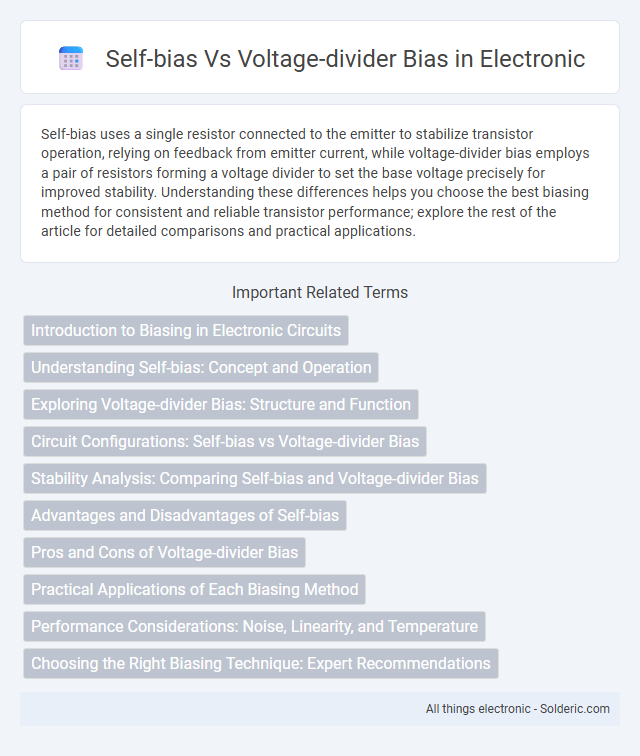Self-bias uses a single resistor connected to the emitter to stabilize transistor operation, relying on feedback from emitter current, while voltage-divider bias employs a pair of resistors forming a voltage divider to set the base voltage precisely for improved stability. Understanding these differences helps you choose the best biasing method for consistent and reliable transistor performance; explore the rest of the article for detailed comparisons and practical applications.
Comparison Table
| Aspect | Self-Bias | Voltage-Divider Bias |
|---|---|---|
| Definition | Biasing method using a single resistor in the emitter for stabilization | Biasing method using two resistors as a voltage divider for improved stability |
| Stability | Moderate stability against b variations and temperature | High stability and less sensitivity to transistor parameter changes |
| Biasing Components | One resistor (emitter resistor) | Two resistors (base voltage divider) + emitter resistor |
| Application | Simple amplifier circuits with less critical stability needs | Widely used in amplifier designs requiring precise bias control |
| Complexity | Simple, fewer components | More complex due to multiple resistors |
| Cost | Lower cost | Higher cost |
| Temperature Effect | More affected by temperature changes | Less affected by temperature variations |
Introduction to Biasing in Electronic Circuits
Biasing in electronic circuits establishes the correct operating point for semiconductor devices, ensuring consistent performance and stability. Self-bias uses a resistor connected to the emitter or source for feedback stabilization, while voltage-divider bias employs a pair of resistors to create a stable reference voltage, enhancing bias stability against variations in transistor parameters. Voltage-divider bias generally offers better thermal stability and minimizes the effects of transistor parameter changes, making it preferred for precision amplification applications.
Understanding Self-bias: Concept and Operation
Self-bias in transistor circuits uses a resistor connected between the emitter and ground, creating a voltage drop that stabilizes the operating point by providing negative feedback. This ensures thermal stability by automatically adjusting the base current as the transistor's temperature changes. The self-bias method offers simple implementation and improved bias stability compared to fixed bias configurations.
Exploring Voltage-divider Bias: Structure and Function
Voltage-divider bias features two resistors connected in series across the supply voltage, creating a stable voltage at the transistor base to enhance biasing stability. This structure reduces variations in transistor operating point caused by temperature fluctuations and transistor parameter changes. Its function ensures consistent collector current and voltage, making it preferable over self-bias circuits in achieving reliable amplifier performance.
Circuit Configurations: Self-bias vs Voltage-divider Bias
Self-bias circuits utilize a single resistor connected between the emitter and ground to stabilize the operating point, making them simpler but less stable against temperature variations. Voltage-divider bias configurations employ two resistors forming a voltage divider network at the base, providing improved stability and precise biasing by fixing the base voltage independently of transistor beta variations. The voltage-divider bias is preferred in amplifier designs requiring consistent performance, while self-bias suits basic applications with minimal component count.
Stability Analysis: Comparing Self-bias and Voltage-divider Bias
Self-bias circuits exhibit limited stability due to dependence on transistor parameters like beta, which vary significantly with temperature and device differences. Voltage-divider bias offers enhanced stability by providing a fixed bias point through a voltage divider network, minimizing the impact of beta variations and temperature changes on operating point. This stable biasing makes voltage-divider bias preferable for consistent transistor operation in analog circuits.
Advantages and Disadvantages of Self-bias
Self-bias offers the advantage of simplicity and fewer external components, making it cost-effective and easy to implement in transistor amplifiers. However, it suffers from poor stability due to temperature variations and transistor parameter changes, which can cause significant shifts in operating point. Voltage-divider bias provides better thermal stability and consistent operating point, but requires more resistors and a more complex circuit design.
Pros and Cons of Voltage-divider Bias
Voltage-divider bias provides excellent stability and improved thermal stability compared to self-bias circuits by maintaining a nearly constant base voltage regardless of transistor beta variations. This biasing method simplifies circuit design for amplifiers needing consistent operating points under various conditions. However, it requires additional resistors, increasing complexity and power consumption, which may be undesirable for low-power or cost-sensitive applications.
Practical Applications of Each Biasing Method
Self-bias is commonly used in small-signal amplifiers where simplicity and thermal stability are critical, making it ideal for low-frequency audio applications. Voltage-divider bias provides better stability against temperature variations and transistor beta changes, making it the preferred choice in high-performance RF amplifiers and precision analog circuits. Your choice depends on the trade-off between circuit complexity and the level of bias stability required for the application.
Performance Considerations: Noise, Linearity, and Temperature
Self-bias circuits often experience higher noise levels and poorer linearity due to their reliance on the transistor's base-emitter voltage, which varies with temperature fluctuations, causing signal distortion and instability. Voltage-divider bias provides superior temperature stability and linearity by maintaining a more constant bias voltage, reducing thermal drift and improving overall performance in precision applications. Your choice between the two influences the circuit's noise performance, linearity, and temperature resilience, with voltage-divider bias generally preferred for demanding analog designs.
Choosing the Right Biasing Technique: Expert Recommendations
Self-bias offers simplicity and thermal stability by using a resistor in the emitter, making it suitable for low-power amplifier circuits. Voltage-divider bias provides superior voltage stabilization and is preferred in precision amplifier designs where the operating point must remain constant despite temperature variations. Experts recommend voltage-divider bias for enhanced stability in medium to high-power transistor applications and self-bias for compact, less sensitive circuits.
Self-bias vs Voltage-divider bias Infographic

 solderic.com
solderic.com